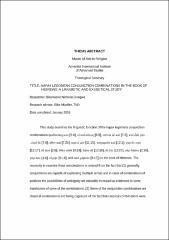| dc.description.abstract | This study examines the linguistic function of the hapax legomena conjunction
combinations (καθώσπερ καὶ [5:4], εἰ καὶ οὕτως [6:9], επειτα δὲ καὶ [7:2], καὶ ὧδε μὲν . .
. ἐκεῖ δὲ [7:8], oθεν καὶ [7:25], καὶ εἰ μὲν [11:15], τοιγαροῦν καὶ [12:1], γὰρ ὅτι καὶ
[12:17], δέ πού [2:6], ὃθεν οὐδὲ [9:18], ὃπου δὲ [10:18], δὲ ἔτι [12:27], γὰρ δήπου [2:16],
γάρ που [4:4], εἰ μὴν [6:14], and επεὶ μήποτε [9:17]) in the book of Hebrews. The
necessity to examine these combinations is derived from the fact that (1) generally
conjunctions are capable of expressing multiple senses and in cases of combinations of
particles the possibilities of ambiguity are naturally increased as evidenced in some
translations of some of the combinations. (2) Some of the conjunction combinations are
classical combinations and being cognizant of the fact that classical combinations were
v
relatively absent from κοινή, these grounds warrant an investigation of their inclusion in
the book of Hebrews in terms of functionality.
A discourse analysis (DA) approach is employed to establish which lexical sense
of the individual conjunctions formulating the combination collocates semantically to
express the intent of the text. Also the functionality of the combination at both the local
and global structural levels is probed. DA is chosen because since conjunctions have a
sequencing function of relating syntactic units, the manner in which they operate is set by
levels of discourse higher than the sentence, that is, by the structure of the paragraph or
section. Therefore, rhetorical structures of the paragraph in which the combinations are
localised is analysed to establish the logico-semantic relation carried by the combinations
and their functionality in the discourse.
The results emanating from the study demonstrated that the conjunction
combinations (1) are emphatic in force on the overall and hence signal prominence and
markedness of the clause or paragraph in which they occur. (2) They express intensity or
specificity of the asserted proposition, that is, increases the shape without increasing the
size. (3) Globally, they are strategically employed in propositions that reinforce the
global aim of the book of Hebrew, that is, the notion of not to look back but rather fixing
eyes on Christ because He is superior and distinct. Finally, the conjunction combinations
signal focality and hence serve a pragmatic function. | en_US |

